|
|
|
Sort Order |
|
|
|
Items / Page
|
|
|
|
|
|
|
| Srl | Item |
| 1 |
ID:
179358
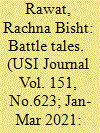

|
|
|
|
|
| Summary/Abstract |
The author has been chronicling wars for a while. She has found that the most fascinating part of the exercise has been the interaction with the magnificent soldiers who fought these wars and came back to us and can now tell us not just their own stories but also those of the braves who could not return. The article narrates some of those stories that she has gathered.
|
|
|
|
|
|
|
|
|
|
|
|
|
|
|
|
| 2 |
ID:
179361
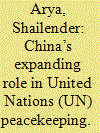

|
|
|
|
|
| Summary/Abstract |
For much of the Cold War period, China was highly sceptical of the concept of United Nations (UN) peacekeeping, viewing it as a thinly veiled disguise for imperialist interventions by the great powers. Further, Deng Xiaoping’s 24 character strategy which stressed on keeping a low profile had guided China’s foreign policy for over two decades. All this has changed under Xi Jinping, wherein UN peacekeeping was identified as a relatively low-risk vehicle to gain global prominence. Consequently, from total opposition to the role of UN itself, China has now transformed as a champion of UN peacekeeping. Today, China provides the 10th largest troop contribution and Beijing is the UN peacekeeping programme’s second largest funder, providing 15 percent of the program’s overall budget. In fact, China provides more personnel to peacekeeping operations than any other permanent member of the Security Council, and has almost twice as many as the other four permanent members combined. This has provided China with global acceptability, significant clout in Africa, and helps to foster China’s image as the leader of the developing world. However, the Chinese intensions are anything but benign. A ‘Wolf Warrior’ diplomacy is on the increase, the Chinese peacekeeping efforts are intertwined with Chinese economic interests, and the overall aim seems to expand Chinese influence across the world.
|
|
|
|
|
|
|
|
|
|
|
|
|
|
|
|
| 3 |
ID:
179313


|
|
|
|
|
| Summary/Abstract |
Contemporary and future full-spectrum warfare would predictably be hybrid in nature, spanning into physical and conceptual dimensions — the former, a swift, intense and short-duration combat against an armed adversary and the latter, a sustained struggle for control and support of the domain of interest. Artificial Intelligence (AI) is fascinating as pursuit of machines to match human decision-making ability, albeit at a higher level of promptness and accuracy — both key components in tactical level of war fighting — hold vital promises for multi-dimensional warfare in fields of command and control, cyberspace, economic aggression, network centric operations, fail proof and predictive analysis of intelligence, deployment of autonomous unmanned platform, autonomous detection-acquisition-classification and engagement of targets, maintenance and upkeep of battle logistics and assets to name a few fields. This paper, while elaborating on conventional AI based force multipliers, also suggests futuristic unexplored application of AI to tilt the balance of power in own favour. The paper concludes with clear and non-utopian recommendation of future roadmaps, containing necessary change management and temporal action plan involving all stakeholders, to support India’s necessity to remain relevant in changing dynamics of warfare through development and deployment of AI and robotics.
|
|
|
|
|
|
|
|
|
|
|
|
|
|
|
|
| 4 |
ID:
179360


|
|
|
|
|
| Summary/Abstract |
The article is based upon a study done by the authors regarding Knowledge management in the Indian Air Force (IAF). The study brings out valuable lessons regarding institutionalising the way to retain the knowledge base of the organisation keeping in mind that personnel moving out of the organisation is inevitable. Though the study is based upon the IAF the findings are of equal relevance to the complete military.
|
|
|
|
|
|
|
|
|
|
|
|
|
|
|
|
| 5 |
ID:
179314
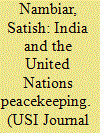

|
|
|
|
|
| Summary/Abstract |
The author with his extensive experience in United Nations (UN) Peacekeeping writes that Peacekeeping is a 50-year-old enterprise that has evolved rapidly in the past decade from a traditional, primarily military model of observing ceasefires and force separations after inter-State wars, to incorporate a complex model of many elements, military and civilian, working together to maintain peace in the dangerous aftermath of civil wars. He brings out the differences between peacekeeping and peace building and brings out that strong military capabilities are a must for peacekeeping while continuity and civilian expertise is best for peacebuilding.
|
|
|
|
|
|
|
|
|
|
|
|
|
|
|
|
| 6 |
ID:
179362
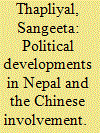

|
|
|
|
|
| Summary/Abstract |
The dissolution of parliament in Nepal has brought the focus back on its fragile democracy. After years of political instability, a new constitution and one party with absolute majority in the general elections gave the impression and hope that the future looked promising for political stability. But that did not take place. Nepalese politics have remained volatile. The article makes an assessment and suggests the path for India keeping in view Chinese machinations.
|
|
|
|
|
|
|
|
|
|
|
|
|
|
|
|
| 7 |
ID:
179359
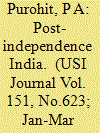

|
|
|
|
|
| Summary/Abstract |
The issue of jointmanship in the Indian Armed Forces assumed greater salience with Revolution in Military Affairs (RMA) and enhanced threats including collusive ones. Although unanimously agreed as a necessity, the perceptions about jointmanship vary across the Services. Analysis of jointmanship exhibited during wars, conflicts and major operations reveals a mixed bag — mainly divergent at the military strategic level yet reasonably good coherence, coordination and execution at the tactical level. To jointly outfight the enemy, the article infers the need of establishing sound Civil-Military Relations (CMR), realistic threat assessment, enhancing joint training, jointly developing capabilities, and rejuvenating existing mechanisms, especially at the strategic level. Importantly, it highlights the difference good leadership and a robust Professional Military Education (PME) makes in enhancing jointness, both in peace and war.
|
|
|
|
|
|
|
|
|
|
|
|
|
|
|
|
| 8 |
ID:
179357


|
|
|
|
|
| Summary/Abstract |
The article looks at the Regimental system of the Indian army, especially in the Infantry. It recounts its advantages and values and gives the reader a feel of the functioning of the system in war and peace. The author embellishes the article with glimpses of Regimental life as he saw and experienced it. He states that the Regimental values like discipline, obedience of orders, comradeship and harmonious officer-men relationship required to be reset in view of social changes were taking place.
|
|
|
|
|
|
|
|
|
|
|
|
|
|
|
|
| 9 |
ID:
179316
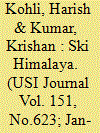

|
|
|
|
|
| Summary/Abstract |
In 1995, commanders at several levels claimed that it was not only difficult but also extremely dangerous to cross the high passes of the Himalaya in deep winter. The sceptics were proved wrong when an eight-member Ski Himalaya Expedition, with two officers, the author and the then Lieutenant Colonel (later Brigadier) Krishan Kumar traversed in the deep winter from the Karakoram Pass in Ladakh to Lipu Lekh, where Uttarakhand meets Nepal. This is a short narration of that epic expedition. For ease of narration it is in the First Person. At the end some recommendations are given.
|
|
|
|
|
|
|
|
|
|
|
|
|
|
|
|
| 10 |
ID:
179315
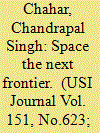

|
|
|
|
|
| Summary/Abstract |
Use of space has fast spread to countries across the globe with enormous implications for security since each state seeks to develop offensive as well as defensive capabilities in space to pursue its security and other interests. India, too, was quick to recognise the potential of space exploration in the development of the country. With a modest start in year 1967 involving launch of first indigenously built sounding rocket from Thumba, the Indian space program has come a long way. The Indian space program has been a civilian one since its inception. With the growing dependence of the armed forces on space-based assets the military applications of this technology cannot be ignored. With each passing day the reliance on space assets is increasing manifold. It is important not only to launch more satellites to meet the growing demand of civilian use but also to meet its military applications. While it is essential to have adequate space assets to meet the ever-increasing requirements of communications, it is prudent to develop an effective anti-satellite weapon system as deterrence against any threat to these space assets. The article argues that if India is to maintain itself as a credible military power into the 21st century, it must exploit this medium.
“Expand on both sides as it is a Quote and not part of Abstract is no ambiguity of purpose. We do not have the fantasy of competing with the economically advanced nations in the exploration of the moon or the planets or manned space-flight. But we are convinced that if we are to play a meaningful role nationally, and in the comity of nations, we must be second to none in the application of advanced technologies to the real problems of man and society.”
|
|
|
|
|
|
|
|
|
|
|
|
|
|
|
|
| 11 |
ID:
179356


|
|
|
|
|
| Summary/Abstract |
This article gives out some salient aspects of Veteran Affairs Health Care System (VAHCS) addressing Health Care of veterans in USA. This is the second article — part of a Trilogy— the first article having been published in USI Journal Apr – Jun 2020 on ‘Evolution of Medical Care Support System in India’. It is a well-known fact that USA has the oldest and largest Veteran Healthcare System in the world. It’s genesis is as old as 1865 and it has evolved in a robust system for veterans’ health care and has large number of positives which can be emulated and adopted in Indian environment. This article covering various facets of Veteran Medical Care Support System in the USA is in two parts wherein this part is focusing on historical evolution, organisational details and eligibility conditions to avail benefits including Enrolment Priority Groups. Part II, which will be published in a subsequent issue, will focus on Medical Benefits, Medically Related Travel, Lodging & Daily allowance and other important aspects of execution / delivery of healthcare of veterans which is the key to its effectiveness.
|
|
|
|
|
|
|
|
|
|
|
|
|
|
|
|
|
|
|
|
|